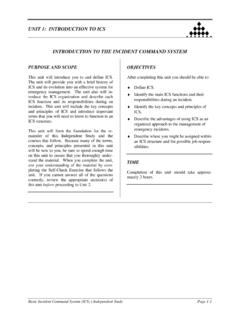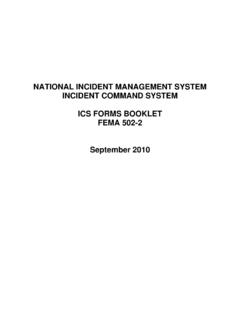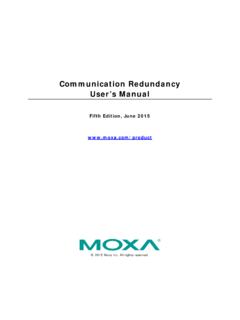Transcription of Incident Command System Operational Description
1 Incident Command System Operational Description February 21, 2012 Table of Contents introduction 1 Section A - Operating Characteristics 3 1) ICS Principles and Features 3 2) ICS Structure 7 3) Incident Management Teams 14 4) Incident Complex 15 5) Area Command 16 Section B.
2 ICS Organization and Operations 18 1) ICS Organization 19 2) Operations Section 24 3) Planning Section 31 4) Logistics Section 37 5) Finance and Administration Section 43 6) Intelligence/Investigations Function 46 7) Establishing and Area Command 48 8) Facilities and Locations 51 9) The Planning Process and the Incident Action Plan 53 10) ICS Forms 62 11)
3 Summary of Major ICS Positions 64 Glossary of Incident Management Terms 68 February 22, 2012 1 introduction The Incident Command System is a standardized on site management System designed to enable effective, efficient Incident management by integrating a combination of facilities, equipment, personnel, procedures, and communications operating within a common organizational structure. ICS has three primary purposes: To provide for the orderly and predictable division of labour To provide for the overall safety at the Incident or event To ensure that the work at the Incident or event is performed efficiently and effectively The System has considerable internal flexibility; it can grow or shrink to meet the changing needs of the Incident or event. ICS has been tested in more than 30 years of applications, in emergency and non emergency situations ranging from small to large incidents, by all levels of government as well as the private sector.
4 In 2002 the Canadian Interagency Forest Fire Centre (CIFFC) and member agencies implemented the Incident Command System (ICS) Canadian Version. Several ICS documents and a complete training curriculum were developed and adopted by wildland fire agencies across the country. The CIFFC documentation focused on the organizational structure and processes for managing wildland fires. Through this document, the use of the ICS has been expanded beyond wildland fire response, to provide a System that will enable organizations to manage any Incident or event, regardless of cause, size, location or complexity. ICS presents standardized organizational structure, functions, processes, and terminology. Standardized processes allow all who respond to the same Incident to formulate a unified plan to manage the Incident . The use of standardized ICS plain-language terminology reduces the risk of miscommunication among the many responders.
5 The System allows response organizations to utilize only those aspects that are practically suited to a given Incident . While the full expansion of the ICS structure may appear complex, this would occur only during complex incidents, and would serve to maintain the optimum span of control by injecting appropriate supervisory levels. Incidents typically begin and end locally, and are managed on a daily basis at the lowest possible geographical, organizational, and jurisdictional level. However, there are instances in which successful Incident management operations depend on the involvement of multiple jurisdictions, levels of government, functional agencies, and/or February 22, 2012 2first responder disciplines. These instances require effective and efficient coordination across this broad spectrum of organizations and activities. The ICS framework forms the basis for interoperability and compatibility that will, in turn, enable a diverse set of public and private organizations to conduct well-integrated and effective Incident response operations.
6 Most incidents are managed locally and are typically handled at a local level by emergency response personnel within a single jurisdiction. The majority of responses need go no further. In other instances, incidents that begin with a single response within a single jurisdiction rapidly expand to multidisciplinary, multi- jurisdictional levels requiring significant additional resources and Operational support. ICS provides a flexible core mechanism for coordinated and collaborative Incident management, whether for incidents where additional resources are required or are provided from different organizations within a single jurisdiction or outside the jurisdiction, or for complex incidents with national, provincial or territorial implications (such as an emerging infectious disease or a bioterrorism attack). When a single Incident covers a large geographical area, multiple local emergency management and Incident response agencies may be required.
7 The responding agencies are defined as the governmental agencies, though in certain circumstances nongovernmental organizations (NGOs) and private-sector organizations may be included. Effective cross-jurisdictional coordination using processes and systems is absolutely critical in this situation. ICS is a fundamental form of management established in a standard format, with the purpose of enabling Incident managers to identify the key concerns associated with the Incident often under urgent conditions without sacrificing attention to any component of the Command System . ICS is used to organize on-scene operations for a broad spectrum of emergencies from small to complex incidents, both natural and manmade. The field response level is where emergency management / first response personnel, under the Command of an appropriate authority, carry out tactical decisions and activities in direct response to an Incident .
8 Resources from the Federal, Provincial, Municipal, First Nations, or other local levels, when appropriately deployed, become part of the field ICS as prescribed by the local authority. As a System , ICS is extremely useful; not only does it provide an organizational structure for Incident management, but it also guides the process for planning, building, and adapting that structure. Using ICS for every Incident or planned event helps hone and maintain skills needed for the large-scale incidents. February 22, 2012 3 SECTION A: ICS OPERATING CHARACTERISTICS 1 ICS PRINCIPLES AND FEATURES ICS is based on a series of proven management features tested and proven effective in industry, various levels of government and response agencies. Each of the following ICS features contributes to the strength and efficiency of the overall System . Common Terminology ICS establishes common terminology that allows diverse Incident management and support organizations to work together across a wide variety of Incident management functions and hazard scenarios.
9 This common terminology covers the following: Organizational Functions Major functions and functional units with Incident management responsibilities are named and defined. Terminology for the organizational elements is standard and consistent. Resource Descriptions Major resources including personnel, facilities, and major equipment and supply items that support Incident management activities are given common names and are typed with respect to their capabilities, to help avoid confusion and to enhance interoperability. Incident Facilities Common terminology is used to designate the facilities in the vicinity of the Incident area that will be used during the course of the Incident . Modular Organization The ICS organizational structure develops in a modular fashion based on the size and complexity of the Incident , as well as the specifics of the hazard environment created by the Incident .
10 When needed, separate functional elements can be established, each of which may be further subdivided to enhance internal organizational management and external coordination. Responsibility for the establishment and expansion of the ICS modular organization ultimately rests with Incident Command , which bases the ICS organization on the requirements of the situation. As Incident complexity increases, the organization expands from the top down as functional responsibilities are delegated. Concurrently with structural expansion, the number of management and supervisory positions expands to address the requirements of the Incident adequately. Management by Objectives February 22, 2012 4 Management by objectives is communicated throughout the entire ICS organization and includes: Establishing Incident objectives. Developing strategies based on Incident objectives. Developing and issuing assignments, plans, procedures, and protocols.








